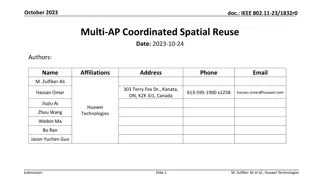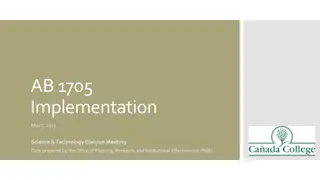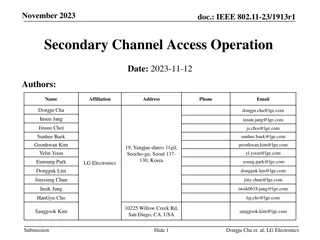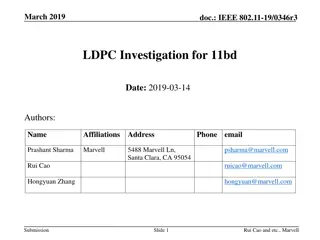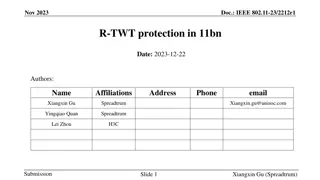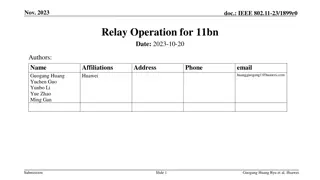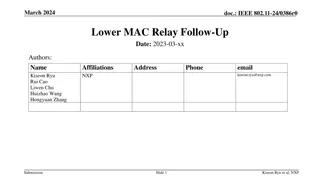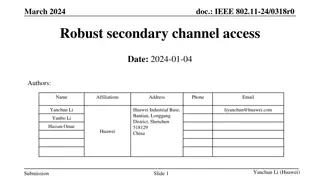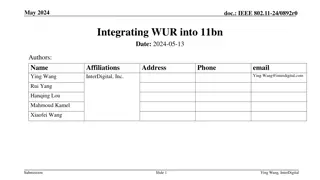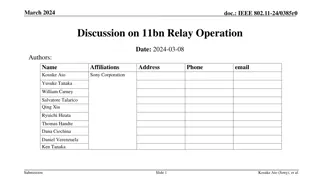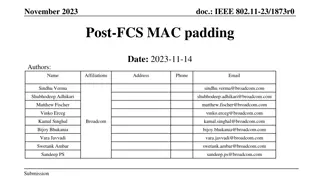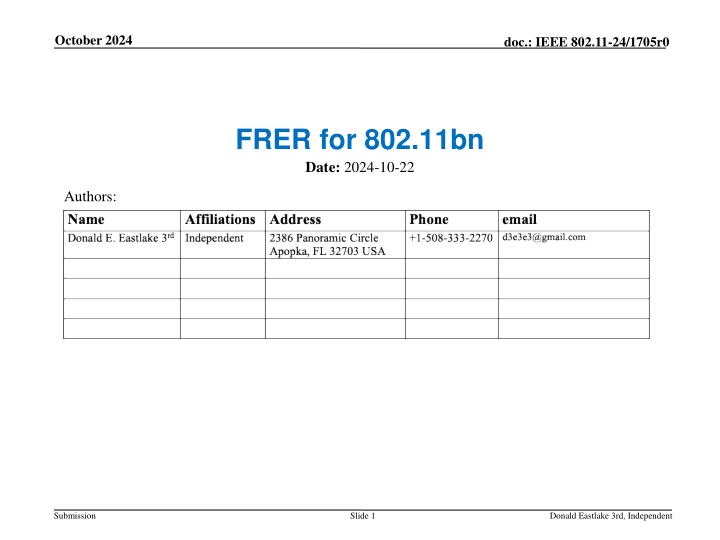
Improving Reliability in IEEE 802.11bn with Frame Replication and Elimination
Enhance reliability in IEEE 802.11bn by implementing Frame Replication and Elimination for Reliability (FRER) as part of IEEE Std. 802.1CB. This approach involves duplicating packets in a Stream to create a Compound Stream, thereby optimizing packet delivery and reducing packet loss. Explore how FRER can benefit network reliability and performance in wireless communications.
Download Presentation

Please find below an Image/Link to download the presentation.
The content on the website is provided AS IS for your information and personal use only. It may not be sold, licensed, or shared on other websites without obtaining consent from the author. If you encounter any issues during the download, it is possible that the publisher has removed the file from their server.
You are allowed to download the files provided on this website for personal or commercial use, subject to the condition that they are used lawfully. All files are the property of their respective owners.
The content on the website is provided AS IS for your information and personal use only. It may not be sold, licensed, or shared on other websites without obtaining consent from the author.
E N D
Presentation Transcript
October 2024 doc.: IEEE 802.11-24/1705r0 FRER for 802.11bn Date: 2024-10-22 Authors: Submission Slide 1 Donald Eastlake 3rd, Independent
October 2024 doc.: IEEE 802.11-24/1705r0 Abstract Transmission of replicated frames between MLDs on multiple links in a way somewhat analogous to IEEE Std 802.1CB can improve reliability in 802.11bn. Submission Slide 2 Donald Eastlake 3rd, Independent
October 2024 doc.: IEEE 802.11-24/1705r0 IEEE Std 802.1CB (Frame Replication and Elimination for Reliability) TSN: 802.1CB is part of 802.1 s Time Sensitive Networking (TSN). TSN s goals are extremely low packet loss and finite, low, and stable end-to- end latencies. (The parallel IETF effort is called DETNET (Deterministic Networking). FRER: 802.1CB Frame Replication and Elimination for Reliability (FRER) is a part of TSN that duplicates packets in a Stream changing it into a Compound Stream with two or more Member Streams. At some points, packets in a Stream are (1) assigned a sequence number with an R-TAG (Redundancy Tag), (2) replicated and sent of different paths. At some points extra copies are dropped and packet may be reordered in sequence. Submission Slide 3 Donald Eastlake 3rd, Independent
October 2024 doc.: IEEE 802.11-24/1705r0 IEEE Std 802.1CB (Frame Replication and Elimination for Reliability) Examples: Submission Slide 4 Donald Eastlake 3rd, Independent
October 2024 doc.: IEEE 802.11-24/1705r0 IEEE Std 802.1CB (Frame Replication and Elimination for Reliability) R-TAG: Octets: 1 2 3 4 5 6 Ethertype 0xF1C1 Reserved Sequence Number Simplified 802.1 Placement: Ethertype / Length Data CRC VLAN TAG R-TAG Destination MAC Source MAC 802.1 is working on a revision PAR for 802.1CB-2017 Submission Slide 5 Donald Eastlake 3rd, Independent
October 2024 doc.: IEEE 802.11-24/1705r0 Mapping 802.1CB to 802.11 Stream identification => assignment of TID to packet R-TAG => mostly already exists in the sequence and packet numbers and the duplicate elimination for infrastructure and other modes With 802.11be Multi-Link Devices, the different links provide redundant paths over which copies can be sent But does 802.11be permit simultaneous transmission of the same MPDU on different links? Probably Submission Slide 6 Donald Eastlake 3rd, Independent
October 2024 doc.: IEEE 802.11-24/1705r0 Draft P802.11be_D7.0 provisions TID-To-Link Mapping (TTLM) gives the set of links on which an MPDU may be sent. Various 802.11be Clauses say: Clause 35.3.16.9: If an MLD has an established block ack agreement with another MLD for a TID, and the transmission of a QoS Data frame of the TID on a link is unsuccessful, the MLD may attempt retransmissions of the frame on any link to which the TID is mapped, subject to Clause 35.3.13: An MLD may deliver individually addressed QoS Data frames belonging to a TID without block ack negotiation to an associated MLD on the setup links subject to For an MLD, the frame retry count and retry limit for each MSDU or A-MSDU that belongs to a TID that requires acknowledgment is implementation specific. Clause 5.1.5.1: the TTLM process that forwards the MPDU(s) based on the TID of the MPDU(s) down to one or more of the MLD lower MAC entities and then to the corresponding PHY SAP. Submission Slide 7 Donald Eastlake 3rd, Independent
October 2024 doc.: IEEE 802.11-24/1705r0 802.1CB for 802.11bn So, what could be done other than clarifying in 802.11bn that an MLD upper MAC sublayer can replicate MPDUs to lower MAC entities for simultaneous transmission on more than one link for reliability? 802.11 could optionally detect R-TAG presence in frames received at the MAC SAP. The presence of such a tag would be a strong indication that the frames has a particularly strong requirement for reliability. This could be used to help classify frames. Using functions outside of 802.11, as specified by 802.1CB, optionally eliminate redundant frames received at a MAC SAP based on R-TAG. If desired, the R-TAG could be removed. Removal might be desirable for frames received at an (MLD) AP for transmission to (MLD) non-AP STAs. Less likely to be desirable for a GLK or mesh which can appear as links in the middle of a network. Also [more to be added] Submission Slide 8 Donald Eastlake 3rd, Independent
October 2024 doc.: IEEE 802.11-24/1705r0 References IEEE Std 802.1CB IEEE Std 802.11be Submission Slide 9 Donald Eastlake 3rd, Independent


